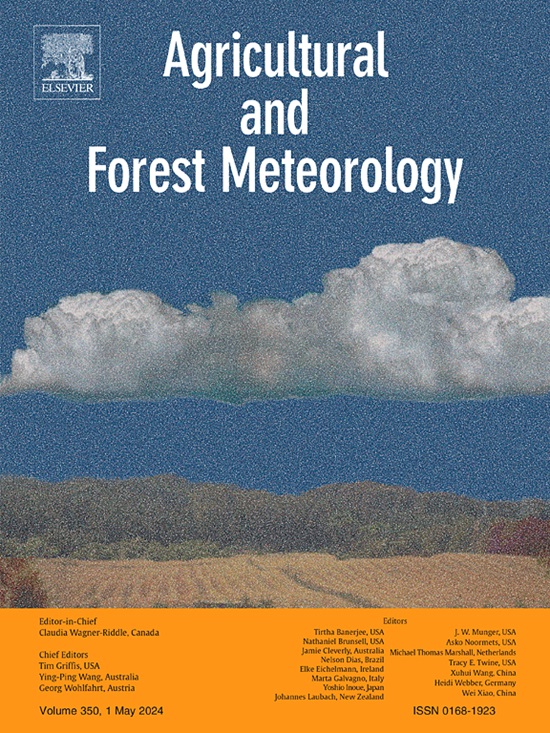Chlorophyll content estimation in radiata pine using hyperspectral imagery: A comparison between empirical models, scaling-up algorithms, and radiative transfer inversions
IF 5.6
1区 农林科学
Q1 AGRONOMY
引用次数: 0
Abstract
Radiata pine (Pinus radiata D. Don) is a widely planted tree species. Fertilizers, especially those containing leaf nitrogen (N) and phosphorous (P), are essential for maximizing growth. Nutrient deficiencies and excessive fertilization can limit growth, so monitoring is crucial. Leaf pigments such as chlorophyll a+b (Ca+b) can be used to assess plant nutrition, specifically leaf N. Remote sensing approaches can be used to monitor forest condition by estimating Ca+b content as a proxy for leaf N. Conventional methods for Ca+b estimation are based on empirical relationships using sensitive spectral indices or inversions of Radiative Transfer Models (RTMs). However, the structural complexity of tree crowns composed of multiple layers of clumped leaves/needles and background and shadow effects challenge the use of the indices proposed for both leaf Ca+b and leaf nitrogen assessment. This study compares the accuracy of methods for Ca+b estimation in radiata pine using hyperspectral data collected from a greenhouse experiment over the growing season and from a field trial representing a stand with a complex structure. The methods used to predict needle Ca+b from tree-crown spectra included: 1) empirical relationships between Ca+b measurements and hyperspectral indices; 2) scaling-up of hyperspectral index-based Ca+b predictive relationships through RTM simulations; and 3) RTM inversions of Ca+b content. These methods were tested over two different segmentation strategies, including sunlit-vegetation and full-crown spectra, to assess the effects of the increased structural complexity.
Predictions of Ca+b from the greenhouse experiment were generally higher for empirical models that used TCARI/OSAVI (Transformed Chlorophyll Absorption in Reflectance Index normalized by the Optimized Soil-Adjusted Vegetation Index) and CI (Chlorophyll index) hyperspectral indices when looking at full-crown rather than sunlit-vegetation pixels. RMSE measurements for full-crown models based on TCARI/OSAVI and CI across the three seasons ranged between 3.60 and 8.71 µg/cm2 and between 3.70 and 7.86 µg/cm2, respectively. Using the scaling-up methodology, the TCARI-OSAVI-derived models were more stable across different methods of pixel extraction than the CI-derived models were, showing the smallest variations across measurement dates. Predictions of Ca+b in the field trial showed that PRO4SAIL2, which combines the PROSPECT-D model with the 4SAIL2 model and accounts for clumping and a more complex tree structure, was more accurate than PRO4SAIL, which couples PROSPECT-D with the original 4SAIL model, across both crown segmentation methods. Using PRO4SAIL2, predictions were more accurate for the full-crown spectra (R² = 0.82; RMSE = 3.35 µg/cm²) than for the sunlit-vegetation pixels (R² = 0.69; RMSE = 4.03 µg/cm²).These results obtained in greenhouse and field trials reinforce the superior performance with forest species of simpler RTM strategies like 4SAIL2, as compared to more complex 3-D approximations, to accurately characterize pine tree-crown traits by integrating multi-layer and clumping effects.
利用高光谱图像估算辐射松的叶绿素含量:经验模型、放大算法和辐射传递反演之间的比较
辐射松(Pinus radiata D. Don)是一种广泛种植的树种。肥料,尤其是含叶片氮(N)和磷(P)的肥料,对最大限度地提高生长至关重要。养分缺乏和施肥过量都会限制生长,因此监测至关重要。叶片色素(如叶绿素 a+b (Ca+b))可用于评估植物营养状况,特别是叶片氮。然而,由多层丛生叶片/针叶组成的树冠结构复杂,加上背景和阴影效应,这对使用叶片 Ca+b 和叶片氮评估指数提出了挑战。本研究比较了利用高光谱数据估算辐射松 Ca+b 的方法的准确性,高光谱数据收集自生长季节的温室实验和代表复杂结构林分的田间试验。根据树冠光谱预测针叶 Ca+b 的方法包括1) Ca+b 测量值与高光谱指数之间的经验关系;2) 通过 RTM 模拟扩大基于高光谱指数的 Ca+b 预测关系;3) 对 Ca+b 含量进行 RTM 反演。在温室实验中,使用 TCARI/OSAVI(通过优化的土壤调整植被指数归一化的反射率中的叶绿素吸收转化指数)和 CI(叶绿素指数)高光谱指数的经验模型,在观测全冠像素而非日照植被像素时,对 Ca+b 的预测普遍较高。基于 TCARI/OSAVI 和 CI 的全冠模型在三个季节的 RMSE 测量值分别为 3.60 至 8.71 微克/平方厘米和 3.70 至 7.86 微克/平方厘米。使用放大方法,TCARI-OSAVI 衍生模型在不同的像元提取方法中比 CI 衍生模型更稳定,在不同测量日期之间的变化最小。野外试验中对 Ca+b 的预测表明,在两种树冠分割方法中,将 PROSPECT-D 模型与 4SAIL2 模型相结合并考虑了丛生和更复杂树体结构的 PRO4SAIL2 比将 PROSPECT-D 与原始 4SAIL 模型相结合的 PRO4SAIL 更准确。使用 PRO4SAIL2,对全树冠光谱的预测(R² = 0.82;RMSE = 3.35 µg/cm²)比对阳光植被像素的预测(R² = 0.69;RMSE = 4.03 µg/cm²)更准确。这些在温室和野外试验中获得的结果证明,与更复杂的三维近似方法相比,4SAIL2 等更简单的 RTM 方法在森林树种中具有更优越的性能,可以通过整合多层和丛生效应来准确描述松树树冠的特征。
本文章由计算机程序翻译,如有差异,请以英文原文为准。
求助全文
约1分钟内获得全文
求助全文
来源期刊
CiteScore
10.30
自引率
9.70%
发文量
415
审稿时长
69 days
期刊介绍:
Agricultural and Forest Meteorology is an international journal for the publication of original articles and reviews on the inter-relationship between meteorology, agriculture, forestry, and natural ecosystems. Emphasis is on basic and applied scientific research relevant to practical problems in the field of plant and soil sciences, ecology and biogeochemistry as affected by weather as well as climate variability and change. Theoretical models should be tested against experimental data. Articles must appeal to an international audience. Special issues devoted to single topics are also published.
Typical topics include canopy micrometeorology (e.g. canopy radiation transfer, turbulence near the ground, evapotranspiration, energy balance, fluxes of trace gases), micrometeorological instrumentation (e.g., sensors for trace gases, flux measurement instruments, radiation measurement techniques), aerobiology (e.g. the dispersion of pollen, spores, insects and pesticides), biometeorology (e.g. the effect of weather and climate on plant distribution, crop yield, water-use efficiency, and plant phenology), forest-fire/weather interactions, and feedbacks from vegetation to weather and the climate system.

 求助内容:
求助内容: 应助结果提醒方式:
应助结果提醒方式:


